The Center for Competitive Politics (CCP), which opposes disclosure of much of the money spent on elections, has declared that “’dark money was nearly non-existent in 2016.’”
Well that is an alternative fact. Dark money—that is, election-related spending whose donors are kept secret from voters—continues to play a major and troubling role in U.S. elections, thanks to a series of U.S. Supreme Court decisions and weak rules and enforcement by the Federal Election Commission (FEC).
So what’s wrong with CCP’s assertion?
First of all, CCP’s dark money estimate only looks at spending that is reported to the FEC—which omits a huge chunk of secret election funds.
Candidate-focused ads that stop short of expressly telling viewers to vote for or against a candidate are only reported to the FEC if they air within 30 days of a primary or 60 days of the general election. For example, Karl Rove’s dark money group One Nation spent $40 million on advertising during the 2016 election cycle supporting vulnerable Republican Senators. Yet, because most of that spending was for ads outside of FEC reporting windows, One Nation reported spending only $3.4 million on the FEC reports apparently relied on by CCP.
What’s more, recent election cycles have seen the rise of what might be called “grey money,” where groups that don’t disclose their donors make pass-through contributions to entities that do, like super PACs. For example, although the Senate Leadership Fund super PAC was required to disclose the $11 million it received from One Nation in 2016, the actual sources of One Nation’s money remains hidden from the public. Thus, dark money ends up fueling super PACs without the public disclosure usually required. Sham Limited Liability Corporations (LLCs) have also been used as a means for donors to contribute to super PACs while keeping their identities secret—an issue that the FEC has been lax in enforcing, and which CLC is currently fighting in court.
Second, using those low-balled dark money numbers, CCP asserts that “’Dark money’ accounted for just 2.9% of total 2016 spending.” But counting dark money as a percentage of overall spending - across all races - is deliberately misleading.
Dark money, like super PAC and other “outside” spending by groups other than candidates and parties, tends to cluster in a handful of the most competitive races. Thanks to factors like gerrymandering, the vast majority of Congressional races are not competitive, and dark money operatives don’t bother spending funds in the many races whose outcome is preordained.
But in those races where dark money is spent, it can be a big factor. In the five most expensive U.S. Senate races in 2016, for example, between ten and twenty percent of outside spending came from entities that keep their donors secret. And in most of these key races, spending on outside advertising exceeded the amounts spent by the candidates themselves. The candidates who benefit from that dark money spending likely know where the money came from—but the public does not.
Overall, the Center for Responsive Politics (a different group from Center for Competitive Politics) found that 12.8 percent of all outside spending came from “dark money” groups that keep their donors hidden from the public. Another 14.2 percent of outside spending came from groups that kept some of their donors secret, like super PACs funded by dark money entities. Only 73 percent of all outside money spent in 2016 was fully disclosed, according to the Center for Responsive Politics analysis.
And, now that President Trump is in office, a new form of dark money is on the rise: at least two secretly-funded nonprofit groups have been formed by Trump allies to support his agenda.
Dark money rises again.
**
UPDATE MAY 10: CCP has responded to our blog, wrongly claiming, among other things, that it is “both false and misleading” when we wrote that “CCP’s dark money estimate only looks at spending that is reported to the FEC.” According to CCP’s Scott Blackburn, CCP’s calculation “does indeed include more than FEC data.”
It is, in fact, CCP’s claim which is false.
The problem is that CCP is basing its claim on an OpenSecrets page which describes a methodology for an entirely different set of data. The page with the relevant OpenSecrets data upon which CCP relied clearly states that the spending estimate is “[b]ased on data released daily by the FEC.” Of course, FEC data only includes “spending that is reported to the FEC.” And, we’ve confirmed with OpenSecrets that our reading of the relevant data is correct.
So, CLC was correct when we wrote that, by relying on the relevant OpenSecrets data, “CCP’s dark money estimate only looks at spending that is reported to the FEC.”
We have asked CCP to correct their erroneous blog.
